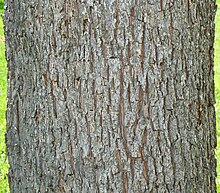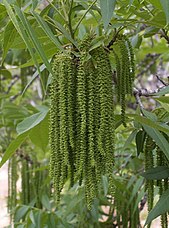Pecan
| Pecan | ||||||||||||
|---|---|---|---|---|---|---|---|---|---|---|---|---|

Pecan tree ( Carya illinoinensis ) |
||||||||||||
| Systematics | ||||||||||||
|
||||||||||||
| Scientific name | ||||||||||||
| Carya illinoinensis | ||||||||||||
| ( Wangenh. ) K. Koch |
The pecan tree ( Carya illinoinensis ), another spelling is pecan , is a species of hickory ( Carya ) within the walnut family (Juglandaceae). He is based in North America and supplies the pecans .
Description and ecology
Appearance, bark, bud and leaf
The pecan tree grows as a tree and reaches heights of 30–50 m, it forms tap roots up to 10 m long. It develops a very large, sweeping treetop , the trunk diameter can be over two meters. The bark is deeply furrowed and light gray to brownish. The tan-colored to reddish-brown bark of the twigs is initially hairy, clearly scaled and often bald later. The yellowish-brown, coarsely hairy and scaly terminal buds are oblong with a length of 6–12 mm; their bud scales do not overlap like roof tiles. The side buds are covered in a hood-like protective cover. The trees can live to over 1000 years.
The 40–70 cm long leaves are divided into a petiole and a leaf blade (lamina) . The 4–8 cm long petiole is glabrous to hairy. The leaf blade is pinnate unpaired . The stalks of the lateral 9–17 leaflets are 0–7 mm long and those of the terminal leaflets are 5–25 mm long. The leaflets are usually 9–13 (7–17) cm long and 1–7 cm wide, ovate to lanceolate or lanceolate and often curved sickle-shaped with a pointed upper end. The leaf margin is finely to roughly serrated, the lamina is often uneven.
Inflorescence and pollination
The flowering time is in spring. Carya illinoinenis is single sexed ( monoecious ) and hetero dichogamous , so there are female ears and male catkins on the same specimen. The yellow-greenish male catkins are sitting and up to 18 cm long and longer than the greenish female ears, they usually bloom before the female flowers ( protandric ), in some varieties afterwards ( protogynous ). The male kittens appear in groups up to three. Carya illinoinensis is pollinated by the wind ( anemophilia ). The flowers are without a flower cover (Achlamydeic). The male flowers are clusters of (three) four to six (eight) stamens with very short filaments surrounded by two smaller, lateral bracts and a larger, central bract , and the female is just one ovary with a large, divided stigma , with a very short style . The ovary is fused with the two dissimilar, four-lobed and basally fused fore and bracts or the covering skin tissue, and the outer ovary wall plus the covering then become the fleshy piece of fruit of the fruit (peel, mesocarp, exocarp).
fruit
The green-brownish fruit when ripe (a nut or opening stone fruit ; Tryma , a false fruit ) is 2.5–6 cm in length and 1.5–3 cm in diameter, almost round or mostly ovate to ellipsoidal and not flattened . The woody endocarp is encased in a four-lobed, 3–4 mm thick, leathery-fibrous, rough shell (mesocarp, exocarp). The shell opens more or less strongly towards the base, the individual lobes are lined with short wings. The nut (endocarp) is tan to brown with black spots, it is almost round or mostly egg-shaped to ellipsoid, more or less pointed on both sides and not flattened, not angular and smooth. The approximately 0.6–1 mm thick shell (endocarp) is thin and easy to crack, the dark brown seed coat is paper-like and edible, it contains two wrinkled, furrowed, light brownish seed kernels ( cotyledons ). The pecan nuts taste similar to the walnut kernels . The weight of the "nuts" is around 5 to 10 g.
Chromosome set
The number of chromosomes is 2n = 32.
use
Pecan oil is made from the shell-free kernels .
Occurrence and growing areas
The natural range is the southern and central North America. In the United States, the distribution area roughly covers the catchment area of the Mississippi . In the north, the states Ohio and Iowa are affected, in the east Virginia , Georgia and Florida , in the west New Mexico . In Mexico , the occurrence includes the Mexican states of Coahuila to Jalisco and Veracruz in the south.
Outside of North America, pecan trees are now cultivated in Hawaii , Australia , Brazil , China , Israel , Peru and South Africa .
Systematics
The first publication took place in 1787 under the name ( Basionym ) Juglans illinoinensis by Friedrich Adam Julius von Wangenheim in contribution to the Teuteschen Holzgrechte forest science. S. 54-55, Figure 43. The new combination to Carya illinoinensis was published in 1869 by Karl Heinrich Koch in Dendrologie , Volume 1, p. 593. Other synonyms for Carya illinoinensis (Wangenh.) K.Koch are: Carya illinoensis (Wangenh.) K. Koch orth. Var., Carya oliviformis (Michx.) Nutt. , Carya pecan (Marshall) Engl. & Graebn. , Hicorius pecan (Marshall) Britton , Juglans oliviformis Michx. , Juglans pecan Marshall .
Carya illinoinensis belongs to the Apocarya section within the genus .
Subspecies / varieties
Most pecan varieties are self-sterile because of dichogamy , so two or more plant specimens are necessary for successful pollination and fruiting. Since Carya illinoinensis is wind pollinated , heavy rainfall during anthesis can prevent pollination.
Because of its valued nuts, Carya illinoinensis has become the subject of breeding efforts, so that there are now very many varieties or cultivated forms that are usually propagated by grafting . These differ from the wild form in that flowering begins earlier and higher yields with larger nuts.
In addition, since the mid-1970s, varieties have been selected from trees in the northern ranges of Carya illinoiensis in the north of the USA and in the south of Canada , which also carry nuts in shorter growing periods - but these usually remain smaller. These are called "Northern Pecan", sometimes also called "Far Northern Pecan".
Others
The pecan has been the official state tree of the US state of Texas since 1919 . Since 1996, the " National Pecan Day " has been celebrated in the USA on April 14th .
literature
- Donald E. Stone Carya : Carya illinoinensis. In: Flora of North America Editorial Committee (Ed.): Flora of North America North of Mexico. Volume 3 - Magnoliidae and Hamamelidae. Oxford University Press, New York / Oxford 1997, ISBN 0-19-511246-6 (Description and Occurrence Sections).
Web links
- JK Peterson: Pecan. USDA Forest Service, accessed July 8, 2013 .
- Pecan on illinoiswildflowers.info, accessed December 14, 2017.
Individual evidence
- ↑ Robert Zander : Zander hand dictionary of plant names. Edited by Fritz Encke , Günther Buchheim, Siegmund Seybold . 15th edition, corrected reprint of the 14th edition. Eugen Ulmer, Stuttgart 1994, ISBN 3-8001-5072-7 .
- ↑ Duden: Pecan .
- ↑ Richmund Rollenbeck: Carya illinoinensis - pecan tree, pecan. In: Jahrb. Bochumer Bot. Ver. 5, 2014, pp. 173–177, online (PDF; 2.5 MB), at botanik-bochum.de, accessed on December 13, 2017.
- ↑ a b c d e f Donald E. Stone Carya : Carya illinoinensis. In: Flora of North America Editorial Committee (Ed.): Flora of North America North of Mexico. Volume 3 - Magnoliidae and Hamamelidae. Oxford University Press, New York and Oxford 1997. ISBN 0-19-511246-6 .
- ↑ Ernest Small: North American Cornucopia. CRC Press, 2014, ISBN 978-1-4665-8592-8 , p. 517.
- ↑ Pecan flowering at USDA / ARS Pecan Breeding Program, accessed December 14, 2017.
- ^ CR Santerre: Pecan Technology. Chapman & Hall, 1994, ISBN 978-94-010-9594-5 , p. 46.
- ↑ Sabine Krist: Lexicon of vegetable fats and oils. 2nd edition, Springer, 2013, ISBN 978-3-7091-1004-1 , pp. 348-353.
- ^ Elbert L. Little, Jr. (and other publications): Digital Representations of Tree Species Range Maps from Atlas of United States Trees. US Department of Agriculture, Forest Service, accessed October 10, 2012 .
- ↑ a b c Carya illinoinensis in the Germplasm Resources Information Network (GRIN), USDA , ARS , National Genetic Resources Program. National Germplasm Resources Laboratory, Beltsville, Maryland. Retrieved October 10, 2012.
- ^ Carya illinoinensis at Tropicos.org. Missouri Botanical Garden, St. Louis, accessed June 30, 2013.
- ↑ The Texas State Tree: Pecan , on lsjunction.com, accessed January 1, 2020
- ↑ Timo Lokoschat : It's getting tight on the calendar. 365 strange commemorative and public holidays. Sanssouci , Munich 2010, ISBN 978-3-8363-0218-0 , p. 65.








